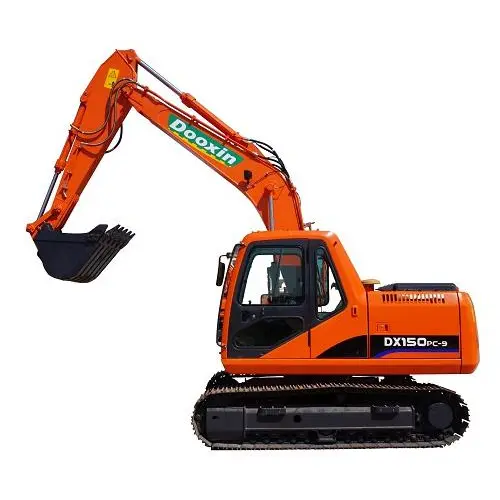Why does a Crawler Excavator change the math of earthmoving today?
2025-11-24
I plan jobs that swing from tight urban trenches to open-cut quarries, and the machine that quietly carries those schedules on its back is the Crawler Excavator. Over years of field feedback, my team at PENGCHENG GLORY has refined a platform that feels natural to operators and decisive in tough ground, so I can line up productivity, safety, and cost without a wrestling match.
What real jobsite problems does a Crawler Excavator actually solve
- Soft or broken ground—the tracked undercarriage spreads load so I can work where wheeled machines sink.
- Mixed tasks in one shift—with quick-coupler and auxiliary circuits, I move from trenching to hammering to lifting without reshuffling the fleet.
- Operator fatigue—stability and smooth hydraulics mean fewer corrections per cycle and a calmer cab by day’s end.
- Compliance and safety—independent audits and European safety approvals keep inspections straightforward and site rules clean.
How do I choose the right tonnage without overbuying or underpowering
I size the Crawler Excavator to the heaviest routine task, not the rarest outlier. Then I check transport limits and under-foot conditions. This keeps utilization high and avoids permits I do not need.
Here is a representative snapshot I use when matching crew, bucket, and ground; figures are typical planning ranges rather than a spec sheet:
| Operating weight class | Typical engine power | Common bucket capacity | Best-fit jobs | Notes I watch |
|---|---|---|---|---|
| ~6 t | 35–45 kW | 0.2–0.3 m³ | Utilities, landscaping, tight city work | Transport on a small trailer, low ground impact |
| ~15 t | 80–95 kW | 0.5–0.8 m³ | Municipal earthworks, road jobs, farm ponds | My “do-most-things” class, great balance of reach and fuel |
| ~36 t | 200–220 kW | 1.3–1.8 m³ | Quarries, bulk cut and load, heavy site prep | Pair with 30–40 t trucks for cycle harmony |
| ~55 t | 300–330 kW | 2.2–3.0 m³ | Mining overburden, mass excavation | Plan haul roads, bench widths, and fuel logistics |
Where does the extra productivity really come from in a Crawler Excavator
- Responsive hydraulics that hold flow under load, so I keep curl, boom, and travel coordinated without starving a function.
- Smart control mapping that lets me fine-tune joysticks and work modes; operators settle in faster and hit cycle targets sooner.
- Clean visibility around the upper-structure with cameras and well-placed lights, which reduces swing hesitation at pile edges.
- Balanced steel—boom, arm, and counterweight are tuned so I work closer to the limits without the machine feeling nervous.
Why does stability in slopes and mud decide my day more than spec sheets
The Crawler Excavator earns its keep when the plan meets real soil. Track length on ground, shoe width, and a low center of gravity make the machine “quiet” over ruts and side-slope. A strong swing bearing and final drives with real torque mean I can climb out of a wet cut, not wish for a tow.
How do I keep operating costs under control across the season
- Fuel—work modes that match task density; I avoid running high-flow when trenching light material.
- Filters and fluids—long-life intervals and grouped service points cut downtime; the Crawler Excavator pays me back every time maintenance happens on the ground.
- Pins and bushings—hard-wear surfaces and good grease routing slow the clock on the front group.
- Telematics—hour tracking and idle reports help me coach operators and spot misuse before it becomes a failure.
Which attachments move revenue per hour instead of just moving dirt
- Hydraulic breaker for utility crossings through rock without calling a subcontractor.
- Tilt-rotator or tilting coupler to shape batters and shoulders in one setup.
- Thumb or grapple for demolition sorting and forestry cleanup.
- Auger and compaction wheel to finish holes and backfill properly.
Because the Crawler Excavator I spec includes robust auxiliary circuits and a quick-coupler option, I turn more small tasks into one-pass wins.
What gives me confidence beyond the iron itself
Independent safety approvals, including CE marking, matter because inspectors do not care about brand stories—they care about documented conformity. Every unit I receive has been checked against global standards and test procedures, then function-tested before shipping. Add in parts availability, clear service manuals, and support I can actually reach, and the Crawler Excavator becomes a predictable asset instead of a gamble.
What simple demo-day checklist keeps my decision honest
- Warm and cold starts feel clean, with no hunting idle.
- Hydraulic motions are simultaneous under load without stalling a function.
- Cab noise stays low enough that I can talk without shouting.
- Swing brake engages smoothly; no jolt when stopping with a full bucket.
- Travel motors pull straight up a loaded ramp; tracks hold line without correction.
- All service points are reachable from the ground; panels open without tools.
How does a mid-class machine become my everyday anchor
The 15-ton class is my backbone: mobile enough for city permits yet strong enough for bulk cut and pipe work. With the right arm length and coupler setup, that Crawler Excavator covers 80% of my weekly ticket without calling in a second machine.
How do we move from research to action today
If you want a balanced, operator-friendly, and hard-wearing Crawler Excavator that slots into real schedules, I am ready to help you match ground conditions, attachments, and transport limits to the right build. Tell me your bucket width, trench depth, and material type, and I will return a clear spec and lead time. Ready for a quote or a demo window—please contact us with your project details, and let’s put the right Crawler Excavator on your site.
